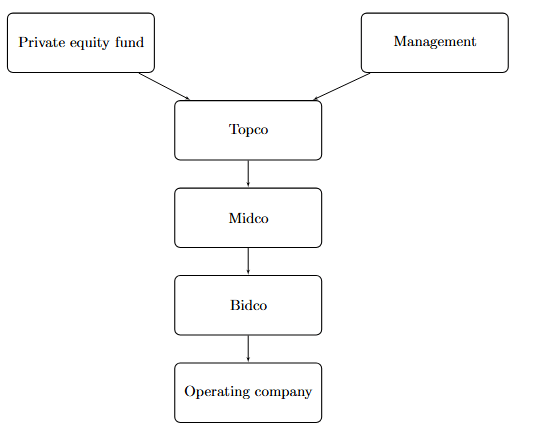Private equity (PE) buyouts introduce complex financial structures that can make it challenging to track portfolio company performance. The use of acquisition vehicles can obscure financial reporting, meaning investors and analysts can have a difficult time trying to understand a company’s true debt levels, profitability, and overall financial health.
This post is the second in my three-part series. It explores the differences between operating entity accounts and consolidated group accounts, highlighting key financial discrepancies and what they mean for investment analysis.
In my first post, I demonstrated how the creation of acquisition vehicles to facilitate PE buyouts creates challenges for analyzing performance with the examples Topco, Midco, and Bidco. Understanding these vehicles (illustrated in Exhibit 1) is important to gain a clear understanding of the target group’s financials during the PE ownership period.
Figure 1. Topco, Midco, Bidco.

After a company is acquired in a PE buyout through such a structure, the consolidated accounts of the target group will typically be recorded at the newly created Topco level, while the operating entity will often file unconsolidated accounts. Other acquisition vehicles like Midco and Bidco will also often file unconsolidated accounts. These accounts, however, may lack complete financial information.
In some cases, more than one company in the group structure will file consolidated accounts. The key to recognizing which set of accounts is the most relevant to fully understanding the group finances is to capture the complete group ownership structure and identify which entity sits at the top of the corporate tree.

To further complicate the process, the post-buyout consolidated reporting entity may change during the PE holding period. This often happens, for example, when other investors acquire a stake in the target group or when the target acquires or merges with other firms. All of this can make accurately studying portfolio company performance from pre- to post-buyout a difficult exercise.
Operating entity accounts often do not capture the full group capital structure, and in some cases, may lack financial information altogether. Moreover, they may not reflect the group cost structure, as some costs may be charged further up in the chain – like at Topco level — so profitability may be stronger at the operating entity level compared to at the consolidated group.
What is more, the debt used to finance the acquisition is often only captured on the accounts of one or more of the newly created acquisition vehicles, meaning that the total debt figure on the balance sheet of the target operating firm may be considerably lower than the consolidated group figure. For buyouts which use a considerable amount of leverage to finance the deal, this will naturally be of even greater importance.

Consolidated Group Accounts vs. Operating Firm Accounts
Table 1 shows a buyout transaction and reports the main financials for both the consolidated group entity, created for the purpose of the acquisition, with the unconsolidated operating entity accounts. The transaction is the acquisition of Xtrac Limited, a UK-based firm, by Inflexion Private Equity Partners LLP, a UK-based PE investor.
Three vehicles were created for the purpose of the buyout: Viola Bidco Limited, Viola Midco Limited, and Viola Holdco Limited. The latter vehicle consolidated the group accounts during the PE ownership tenure. Panel A shows the financials of the operating entity, while panel B shows the financials of the consolidated group entity.
There are differences across reported sales, assets, and headcount, all of which are which are lower at the operating entity level. On the other hand, EBITDA (earnings before interest, taxation, depreciation, and amortization) is higher at the operating entity level. Short- and long-term company debt is considerably lower at the operating entity level. These differences will naturally have implications for any financial ratios which are calculated, such as profitability and leverage.
Table 1 illustrates Inflexion Private Equity Partners’ acquisition of Xtrac Limited in 2017 and its exit in 2023. Panels A and B compare financial accounts of both the operating entity (Panel A) and the consolidated group entity (Panel B), which was created for the purpose of the buyout in 2017.
Table 1. Consolidated and Operating Firm Accounts.

I studied a sample of almost 3,000 PE buyouts in the United Kingdom over the past two decades and summarized my findings in a recent research article. In it, I document the difference in PE target group financials between the operating firms and the consolidated group entities. There are marked differences in sales, assets, earnings, debt, and cash holdings.
For example, the median difference in total assets in the first full year after the buyout between the consolidated group accounts and the operating firm accounts is 77%. The median difference in total debt is 244%, underlining that operating entity accounts do not fully reflect the size of the portfolio company’s consolidated group balance sheet. These differences are even greater in buy-and-build deals, where the target company acquires other firms during the PE holding period.
Key Takeaways
Understanding the differences between operating entity accounts and consolidated group accounts is essential for accurate financial analysis of PE-owned firms. The evidence shows major discrepancies in reported assets, debt, earnings, and profitability. Yet, these metrics can significantly impact valuation, risk assessment, and investment decisions.
As the PE landscape evolves, investment professionals must understand how to correctly capture the full picture of a portfolio company’s performance — especially in leveraged buyouts and buy-and-build strategies, where these differences are most pronounced. In my final post in this series, I will examine the implications these differences have when studying the capital structure and performance of PE-owned companies, and I will shed light on important accounting elements of buyout targets’ balance sheets.






